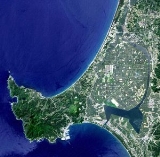
Hachirogata
Encyclopedia

Lake
A lake is a body of relatively still fresh or salt water of considerable size, localized in a basin, that is surrounded by land. Lakes are inland and not part of the ocean and therefore are distinct from lagoons, and are larger and deeper than ponds. Lakes can be contrasted with rivers or streams,...
in the Akita Prefecture
Akita Prefecture
is a prefecture of Japan located in the Tōhoku Region of northern Honshu, the main island of Japan. The capital is the city of Akita.- History :The area of Akita has been created from the ancient provinces of Dewa and Mutsu....
in northern Japan
Japan
Japan is an island nation in East Asia. Located in the Pacific Ocean, it lies to the east of the Sea of Japan, China, North Korea, South Korea and Russia, stretching from the Sea of Okhotsk in the north to the East China Sea and Taiwan in the south...
. Its formal name is Lake Hachirō (八郎湖 Hachirō-ko), but it is also called Hachirōgata Regulating Pond (八郎潟調整池 Hachirōgata chōseichi). At 4 meters below sea level, Hachirōgata is now the lowest point in Japan.
Hachirōgata was the second-largest lake in Japan after Lake Biwa
Lake Biwa
is the largest freshwater lake in Japan, located in Shiga Prefecture , northeast of the former capital city of Kyoto. Because of its proximity to the ancient capital, references to Lake Biwa appear frequently in Japanese literature, particularly in poetry and in historical accounts of battles.-...
. Extensive reclamation began in 1957 for crop production, and Ōgata
Ogata, Akita
is a village located in Minamiakita District, Akita, Japan.As of 2011, the village has an estimated population of 3,242 and a density of 19.1 persons per km². The total area is 170.05 km².This village is made up entirely of reclaimed land...
village was established on the reclaimed land on October 1, 1964. The remaining lake has an area of 48.3 km² (19 sq mi) (18th largest in Japan).
Some regard the reclamation as a mistake, since Japan began to be bothered with surplus rice
Rice
Rice is the seed of the monocot plants Oryza sativa or Oryza glaberrima . As a cereal grain, it is the most important staple food for a large part of the world's human population, especially in East Asia, Southeast Asia, South Asia, the Middle East, and the West Indies...
soon after the completion of the reclamation. Others lament the loss of the wetland
Wetland
A wetland is an area of land whose soil is saturated with water either permanently or seasonally. Wetlands are categorised by their characteristic vegetation, which is adapted to these unique soil conditions....
s.
Fishery of shijimi shells (Corbicula
Corbiculidae
The Corbiculidae, common name "basket clams", are a family of aquatic bivalve molluscs in the order Veneroida.Clams in this family release many juveniles into the surrounding waters that have hatched inside the clams . Fertilization is internal...
japonica) was a thriving industry, but it decreased as the lake became less brackish. In the winter, people fish wakasagi (Hypomesus nipponensis
Hypomesus nipponensis
Also called wakasagi, Hypomesus nipponensis is an important food fish native to the lakes and estuaries of Hokkaido, Japan, although it has been introduced to other locations, including the San Francisco Delta of the United States....
) by hollowing out the frozen surface. Today, black bass
Black bass
Micropterus , is a genus of freshwater fish in the sunfish family of order Perciformes. The type species is M. dolomieu, the smallmouth bass...
fishing attracts tourists even outside the prefecture, though some suspect that indigenous species are threatened by the invasion of the extraneous fish.
Legend
According to a legend, a man called Hachirō who was transformed into a dragonChinese dragon
Chinese dragons are legendary creatures in Chinese mythology and folklore, with mythic counterparts among Japanese, Korean, Vietnamese, Bhutanese, Western and Turkic dragons. In Chinese art, dragons are typically portrayed as long, scaled, serpentine creatures with four legs...
chose the lake for his home after wandering a long time. Thus, the lake was named Hachirōgata (-gata means "lagoon"). Later, he was attracted to a woman who owned Lake Tazawa
Lake Tazawa
is a caldera lake in Semboku, Akita Prefecture, northern Japan. It is the deepest lake in Japan . Because of its depth, it never freezes....
, another lake in Akita Prefecture, and moved to be with her. After that, Hachirōgata became increasingly shallower.

